Intel's Core i7 870 & i5 750, Lynnfield: Harder, Better, Faster Stronger
by Anand Lal Shimpi on September 8, 2009 12:00 AM EST- Posted in
- CPUs
New Heatsinks and Motherboards
LGA-1156 processors use a different heatsink than both LGA-1366 and LGA-775 chips.
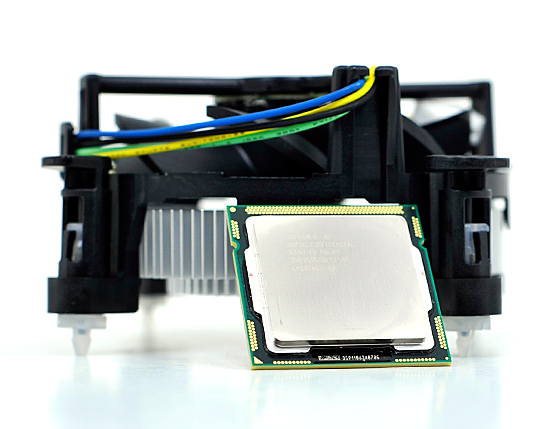
Lynnfield and its cooler
As the numbers would imply, the LGA-1156 heatsink has a larger footprint than LGA-775 but smaller than LGA-1366.
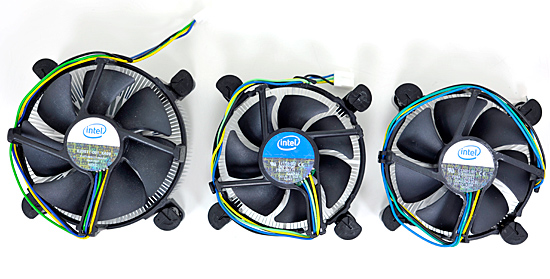
From Left to Right: Retail LGA-1366 Cooler, Retail LGA-1156 Cooler, Retail 45nm LGA-775 Cooler
The retail LGA-1156 is actually much closer to the 45nm LGA-775 retail cooler than the LGA-1366 retail HSF:
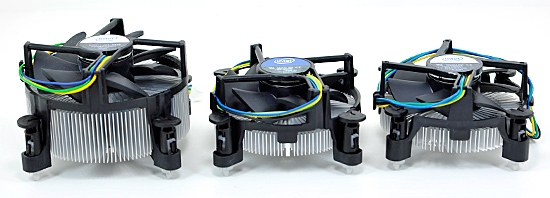
As you'll see later on in the article, the retail cooler isn't very good for heavy overclocking. Power users will want something a little bigger:
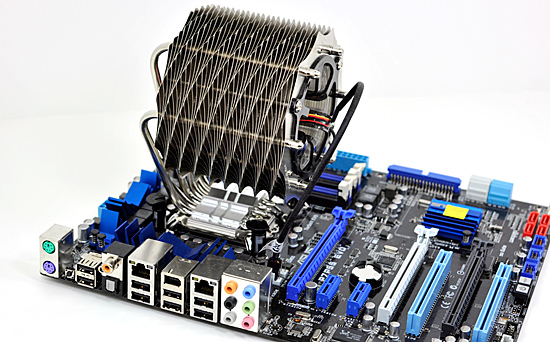
The Lynnfield/P55 launch is huge. Virtually every single motherboard manufacturer has a P55 board available. Prices range from ~$110 - $300 depending on the number of bells and whistles.

Gigabyte's ultra high end UD6 (left) and Gigabyte's lower end micro-ATX UD4 (right)
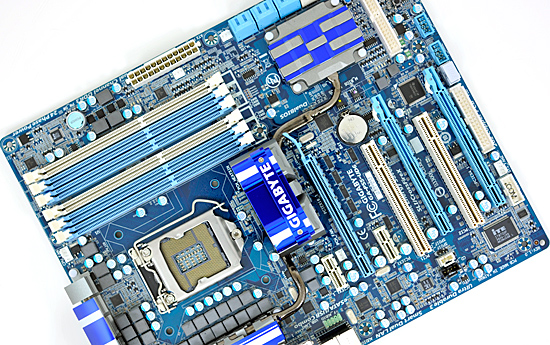
Gigabyte's high end UD6 comes with 6 DIMM slots like its X58 brethren.
Micro-ATX is increasing in popularity and we actually have some good options this time if you're trying to build a smaller Lynnfield system. Combined with Lynnfield's excellent idle power (the lowest of any quad-core we've ever tested), this could make for an unusually potent HTPC.
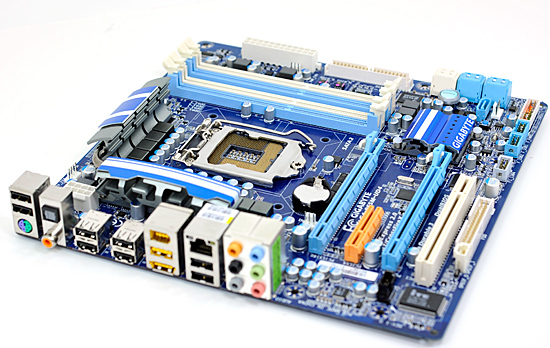
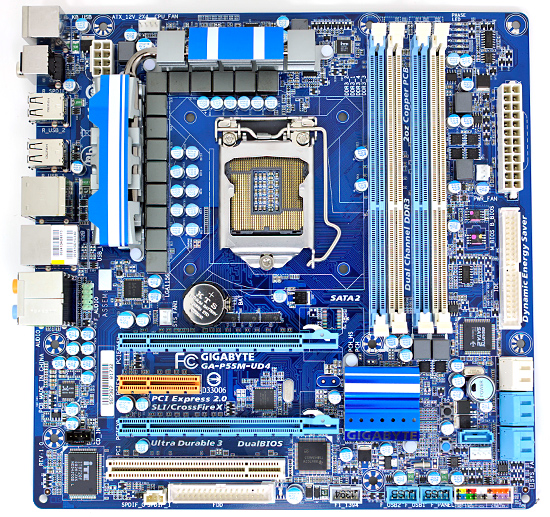
A closer look at Gigabyte's micro-ATX P55M-UD4
The only thing we're really missing is a good mini-ITX Lynnfield board. But perhaps the manufacturers will wait until we have on-package graphics before going down that route...
One More Time: New H55 Boards Next Year
As I subtley implied at the end of the last section, Intel is bringing on-package graphics to Nehalem starting in Q4 of this year:
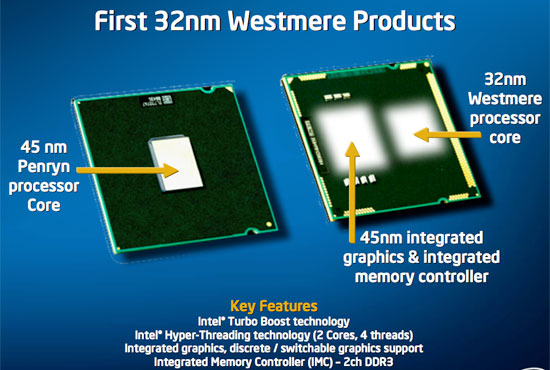
The 32nm Nehalem shrink, codenamed Westmere, will be available with a 45nm Intel graphics core on the processor's package. This graphics core is an evolution of what's currently in the G45 chipset and not Larrabee (although eventually that will change). From what I've heard, this is actually going to be Intel's first reasonably good integrated graphics core.
With the graphics on-package, there needs to be an interface from the processor socket to video output located on the motherboard. As you can see from the P55 motherboards that are launching today: none of them have this video out. Granted there aren't any CPUs out to take advantage of it either.

No DVI/HDMI/VGA out...yet
Early next year (or maybe even late this year) we'll see a new breed of LGA-1156 motherboards with video output, designed for use with these Westmere IGP parts. Rumor has it that these motherboards will use Intel's H55 chipset.
Lynnfield early adopters need not worry, 32nm quad-core processors won't be out for at least a year.










343 Comments
View All Comments
yacoub - Tuesday, September 8, 2009 - link
lol, what a stupid comment. yes it's "cheating" to benchmark the processor the way it comes out of the box, which also happens to be how it is used in the real world environment.Voo - Tuesday, September 8, 2009 - link
Well there are many users who don't bother with overclocking so the tests aren't "illegal" or anything.But I tend to agree that most users who would be interested in buying an i7 920 or i7 860 would overclock it, so turbo mode wouldn't help at all, as we see with the OC results.
I'm curious if PCI-e on die is the only problem and if we'll see new chips who benefit from turbo mode even when overclocked. After all the principle behind turbo mode doesn't change if you overclock, does it?
james jwb - Tuesday, September 8, 2009 - link
IF that's true, i'm not at all happy with this review. But i'll wait for someone else to confirm this for obvious reasons... anand, confirm!Voo - Tuesday, September 8, 2009 - link
You read the text, didn't you? It was mentioned several times..james jwb - Tuesday, September 8, 2009 - link
i don't have time to read through all of it right now, was just flicking through and immeditaly thought to ask the question. I will read it fully later on, though.Hence why i asked the question. You say "it", as in which way, benches had turbo, benches didn't?
snakeoil - Tuesday, September 8, 2009 - link
yes again, turbo was on for all the benchmarks which is illegal and biased.maxxcool - Tuesday, September 8, 2009 - link
yes, the federal government says making a feature that makes your product better is legal.JarredWalton - Tuesday, September 8, 2009 - link
Illegal and biased? Yes, Intel is illegally making their CPUs run better at all workloads for normal users that don't overclock. Someone should arrest them! What would be biased is to test these CPUs in a fashion that artificially limits performance. Sure, it would be nice to see performance compared with and without Turbo enabled, but generally there's not enough time to run every potentially interesting test scenario.snakeoil - Tuesday, September 8, 2009 - link
there you go, finally you said it.all the benchmarks have at least 600 mhz over the processor's stock speed.
that is outrageous, then if you want to compare the result with phenom 2 you have to overclock phenom 2 at least 600 mhz over stock speed.
just to be fair
Anand Lal Shimpi - Tuesday, September 8, 2009 - link
The processor's stock speed is variable according to the workload it's running, that's what turbo mode does. AMD will enable similar functionality in 2011. This is the out-of-box performance of Lynnfield. Turbo mode is a feature of the processor as it has been since the mobile Penryn days (and more recently Nehalem). There's no reason to disable it as no end user would, unless you want to make Intel look worse for some reason.We also ran Turbo on vs. off numbers in the review: http://anandtech.com/cpuchipsets/showdoc.aspx?i=36...">http://anandtech.com/cpuchipsets/showdoc.aspx?i=36...
Take care,
Anand